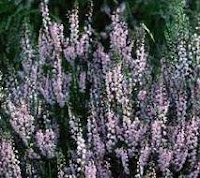 Heath, common name for a plant family comprising flowering plants that are widely distributed in both temperate and tropical regions of the world, and for its representative genus. The family contains about 3350 species, which are placed in more than 100 genera and include a large number of ornamentals. Important horticultural members of the family are rhododendrons and azaleas (see Rhododendron), heath, heather, madrona, mountain laurel, sweetbell, and sourwood. Various species produce such fruit as the blueberry, cranberry, and huckleberry. Briar pipes are made from burls of heath species native to the Mediterranean area.
Heath, common name for a plant family comprising flowering plants that are widely distributed in both temperate and tropical regions of the world, and for its representative genus. The family contains about 3350 species, which are placed in more than 100 genera and include a large number of ornamentals. Important horticultural members of the family are rhododendrons and azaleas (see Rhododendron), heath, heather, madrona, mountain laurel, sweetbell, and sourwood. Various species produce such fruit as the blueberry, cranberry, and huckleberry. Briar pipes are made from burls of heath species native to the Mediterranean area.Most members of the heath family are woody, often evergreen shrubs. Many are poisonous; indeed, many common cultivated species contain the toxin andromedotoxin, which causes vomiting and reduced blood pressure and may result in death if taken in large quantities. Azaleas, rhododendrons, sweetbells, and laurels all contain this compound.
The flowers are characterized by four or five sepals (outer floral whorls) and four or five petals (inner floral whorls) that are fused at the base to form a tube. The stamens (male floral organs) are usually twice as numerous as the petals, and the anthers (pollen-bearing structures) open by terminal pores rather than by longitudinal slits, as they do in most families of flowering plants. The ovary (female floral organ) is usually superior (borne above and free from the other floral parts).
Most members of the order to which the heath family belongs are woody plants, with small trees and shrubs predominating. Some tropical species are epiphytes (plants growing on other plants for support but not nourishment). A number of species, such as the Indian pipe, lack chlorophyll, the food-producing pigment that is found in most plants, and are parasitic, depending on other green plants for their nourishment.
Although the order is widely distributed, its members occur mainly in cooler areas. Thus, in tropical regions they are found mainly in mountainous areas. In addition, most members of the order occur in acid soils.
The seven other families of the order contain only a few species each and have limited economic importance as ornamentals. They are also used in local medicines.
Scientific classification: Heaths make up the family Ericaceae, of the order Ericales. The representative genus is Erica. The Indian pipe is classified as Monotropa uniflora in the family Pyrolaceae.



